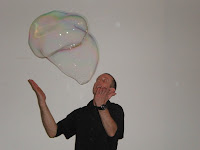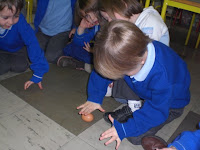
Friday, November 21st, 2008
It is Science Week in Galway. Actually, in Galway it is a Science Fortnight, starting last week and finishing with a very exciting Science Exhibition in Salthill in Galway on Sunday. In our school all the teachers and pupils walked to Galway Education Centre to see a fantastic Bubble Show. Three of our Junior Infant classes also got to go to a show given by the Armagh Planetarium.
Steve was our bubble man. He blew lots of bubbles, small ones and then big ones. He showed us the 7 colours that can be seen in bubbles - red, orange, yellow, green, blue, indigo and violet (the colours of the spectrum, same as the colours in the rainbow). Steve showed us how to guess when a bubble will burst - it will turn from colourful to blue, then to gold, white, and will finally burst.


Next we got to move bubbles with our hands and by blowing them. That was great fun. Steve showed us that bubbles are always spheres, regardless of whether they are blown through a circular wand, a

square wand or through your hand. We saw bubbles really clearly when Steve blew smoke into the bubbles.

He even showed us how to bounce bubbles, put our hands through them, how to blow a bubble inside another bubble, and how to make a string of bubbles all joined together.

We can make really good bubble mixture using wash up liquid, water and glycerine. We are looking forward to having lots of fun ourselves with our bubbles.



 Today we learned all about the Water Cycle. We know that water when heated will turn in to gas (this is called evaporation). Gas outside will form clouds, clouds will join together to form bigger clouds and they will let the water fall back to earth as rain. This rain will turn to puddles, rivers and seas. The sun outside will cause the water again to evaporate, and the water cycle will keep on going.
Today we learned all about the Water Cycle. We know that water when heated will turn in to gas (this is called evaporation). Gas outside will form clouds, clouds will join together to form bigger clouds and they will let the water fall back to earth as rain. This rain will turn to puddles, rivers and seas. The sun outside will cause the water again to evaporate, and the water cycle will keep on going.


 Next Sunday is the First Sunday of Advent. We made Advent Wreaths with 3 purple candles and one pink one. We will look out for wreaths if we go to church this Sunday.
Next Sunday is the First Sunday of Advent. We made Advent Wreaths with 3 purple candles and one pink one. We will look out for wreaths if we go to church this Sunday.



 We found that wash-up liquid and bread soda both turned the water a blue-green colour. These are alkalis.
We found that wash-up liquid and bread soda both turned the water a blue-green colour. These are alkalis.

 We found out that when you spin a raw egg and then gently put your hand on it and then take your hand off the egg, that the egg keeps on spinning. This is because the inside of the egg is not solid, and will keep moving once it has started moving, if it can - rather like a child in a car who has no seat belt on will keep on moving forward if the car comes to a sudden stop.
We found out that when you spin a raw egg and then gently put your hand on it and then take your hand off the egg, that the egg keeps on spinning. This is because the inside of the egg is not solid, and will keep moving once it has started moving, if it can - rather like a child in a car who has no seat belt on will keep on moving forward if the car comes to a sudden stop. If you spin a cooked egg, put your hand on it and then remove your hand, the egg will not continue moving, it will stop. This is because the inside of a cooked egg is solid, so it is like a child in a car wearing a seat belt - if the car stops suddenly the child will also stop.
If you spin a cooked egg, put your hand on it and then remove your hand, the egg will not continue moving, it will stop. This is because the inside of a cooked egg is solid, so it is like a child in a car wearing a seat belt - if the car stops suddenly the child will also stop. We learned a lot about raw and cooked eggs, and also about how important it is to wear a seat belt at all times when travelling in the car.
We learned a lot about raw and cooked eggs, and also about how important it is to wear a seat belt at all times when travelling in the car. Today our school had a visit from a Theatre Group. They performed the pantomime "Beauty and the Beast".
Today our school had a visit from a Theatre Group. They performed the pantomime "Beauty and the Beast". It was a marvellous show and we really enjoyed it. Some of us will be in the Renmore version of Beauty and the Beast and will be performing in the Town Hall Theatre in Galway at the start of January 2009.
It was a marvellous show and we really enjoyed it. Some of us will be in the Renmore version of Beauty and the Beast and will be performing in the Town Hall Theatre in Galway at the start of January 2009.

 Friday, November 21st, 2008
Friday, November 21st, 2008
 Next we got to move bubbles with our hands and by blowing them. That was great fun. Steve showed us that bubbles are always spheres, regardless of whether they are blown through a circular wand, a
Next we got to move bubbles with our hands and by blowing them. That was great fun. Steve showed us that bubbles are always spheres, regardless of whether they are blown through a circular wand, a
 He even showed us how to bounce bubbles, put our hands through them, how to blow a bubble inside another bubble, and how to make a string of bubbles all joined together.
He even showed us how to bounce bubbles, put our hands through them, how to blow a bubble inside another bubble, and how to make a string of bubbles all joined together.  We can make really good bubble mixture using wash up liquid, water and glycerine. We are looking forward to having lots of fun ourselves with our bubbles.
We can make really good bubble mixture using wash up liquid, water and glycerine. We are looking forward to having lots of fun ourselves with our bubbles.


 In our class we decided to try making our own aeroplanes out of a sheet of paper.
In our class we decided to try making our own aeroplanes out of a sheet of paper.

 Waterproof Materials: Plastic, bottles, cups, wet weather trousers, tins, ice cream containers, jackets, our skin.
Waterproof Materials: Plastic, bottles, cups, wet weather trousers, tins, ice cream containers, jackets, our skin.
 Absorbent Materials: Newspaper, tissue, toilet paper, cloth.
Absorbent Materials: Newspaper, tissue, toilet paper, cloth. We have a thermometer and a water gauge in our class. Each morning we put them outside to measure the daily temperature and how much rain has fallen while we are at school.
We have a thermometer and a water gauge in our class. Each morning we put them outside to measure the daily temperature and how much rain has fallen while we are at school.
 Teacher got a candle. She put it on a stand, in a basin, with coins beside it. Then she put a glass jar (full of air) over the candle.
Teacher got a candle. She put it on a stand, in a basin, with coins beside it. Then she put a glass jar (full of air) over the candle. The candle stayed lighting in the air for a while, until all the air got used up. Then the candle went out. Now because the jar was empty (all the air was used up) the water rushed in to fill the space in the jar.
The candle stayed lighting in the air for a while, until all the air got used up. Then the candle went out. Now because the jar was empty (all the air was used up) the water rushed in to fill the space in the jar.  Look at all the water that rushed into the jar to fill up the space that the air used to take.
Look at all the water that rushed into the jar to fill up the space that the air used to take.
 Then it went out because the burning candle used all the air in the glass.
Then it went out because the burning candle used all the air in the glass. Teacher tried again, this time with a jar.
Teacher tried again, this time with a jar.  The candle burned for longer because there was more air in the jar than in the glass. We counted how many seconds each candle burned for.
The candle burned for longer because there was more air in the jar than in the glass. We counted how many seconds each candle burned for.  Next teacher put ice cubes into the glass. After a while tiny drops of water formed on the outside of the glass. This is because some of the water vapour in the air changed to liquid when it touched the cold glass.
Next teacher put ice cubes into the glass. After a while tiny drops of water formed on the outside of the glass. This is because some of the water vapour in the air changed to liquid when it touched the cold glass.  After burning the candle for a while, each time lighting it and waiting until it went out, the inside of the jar became a bit wet.
After burning the candle for a while, each time lighting it and waiting until it went out, the inside of the jar became a bit wet.  This is because the hydrogen in the candle joined with the oxygen in the air to form water.
This is because the hydrogen in the candle joined with the oxygen in the air to form water. 
 When we shook the cup, the ball ended up on the top. This is because the little rice pieces rush in to fill any air spaces caused by the shaking. This means that the ball ends up on the top each time. This explains why all the big pieces of cereal are always at the top of the cereal box when we open it.
When we shook the cup, the ball ended up on the top. This is because the little rice pieces rush in to fill any air spaces caused by the shaking. This means that the ball ends up on the top each time. This explains why all the big pieces of cereal are always at the top of the cereal box when we open it.